Impacts of FDI and Trade on Economic Growth of India
VerifiedAdded on 2023/06/12
|18
|3830
|90
AI Summary
This research proposal aims to analyze the impacts and implications of the inflow of FDI and the trade activities of India on the growth dynamics of the economy of the country. The proposal includes a literature review, research questions, research methodology, and research timetable. The primary research question is how has the economic growth of India been affected over the years by the dynamics in FDI and the trade sector of the country. The research methodology involves a quantitative approach involving statistical methods for analysis of the collected data and thus, adheres to Positivism as its chosen philosophical approach.
Contribute Materials
Your contribution can guide someone’s learning journey. Share your
documents today.

Running head: RESEARCH PROPOSAL
Research Proposal
Name of the Student
Name of the University
Author Note
Research Proposal
Name of the Student
Name of the University
Author Note
Secure Best Marks with AI Grader
Need help grading? Try our AI Grader for instant feedback on your assignments.
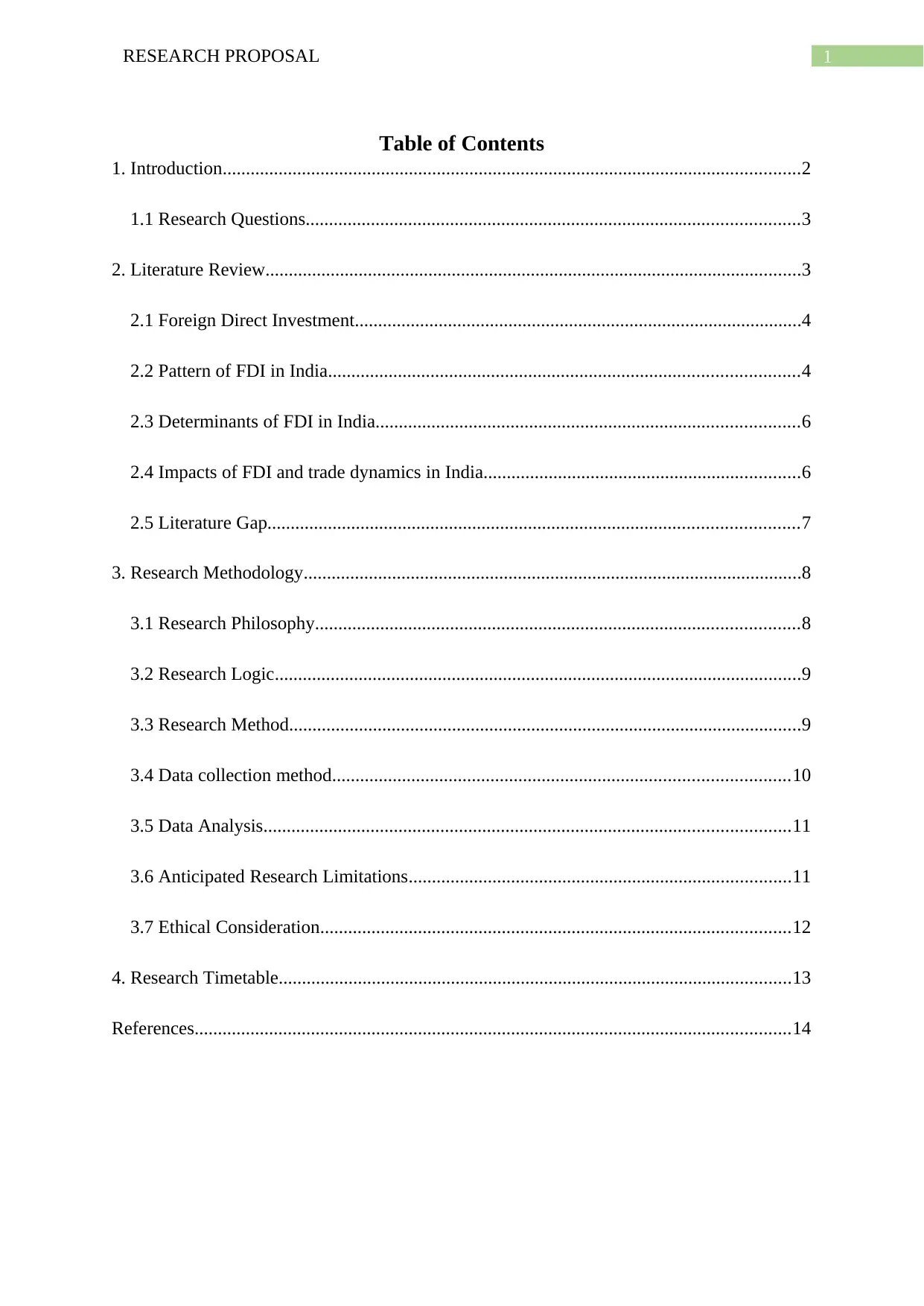
1RESEARCH PROPOSAL
Table of Contents
1. Introduction............................................................................................................................2
1.1 Research Questions..........................................................................................................3
2. Literature Review...................................................................................................................3
2.1 Foreign Direct Investment................................................................................................4
2.2 Pattern of FDI in India.....................................................................................................4
2.3 Determinants of FDI in India...........................................................................................6
2.4 Impacts of FDI and trade dynamics in India....................................................................6
2.5 Literature Gap..................................................................................................................7
3. Research Methodology...........................................................................................................8
3.1 Research Philosophy........................................................................................................8
3.2 Research Logic.................................................................................................................9
3.3 Research Method..............................................................................................................9
3.4 Data collection method..................................................................................................10
3.5 Data Analysis.................................................................................................................11
3.6 Anticipated Research Limitations..................................................................................11
3.7 Ethical Consideration.....................................................................................................12
4. Research Timetable..............................................................................................................13
References................................................................................................................................14
Table of Contents
1. Introduction............................................................................................................................2
1.1 Research Questions..........................................................................................................3
2. Literature Review...................................................................................................................3
2.1 Foreign Direct Investment................................................................................................4
2.2 Pattern of FDI in India.....................................................................................................4
2.3 Determinants of FDI in India...........................................................................................6
2.4 Impacts of FDI and trade dynamics in India....................................................................6
2.5 Literature Gap..................................................................................................................7
3. Research Methodology...........................................................................................................8
3.1 Research Philosophy........................................................................................................8
3.2 Research Logic.................................................................................................................9
3.3 Research Method..............................................................................................................9
3.4 Data collection method..................................................................................................10
3.5 Data Analysis.................................................................................................................11
3.6 Anticipated Research Limitations..................................................................................11
3.7 Ethical Consideration.....................................................................................................12
4. Research Timetable..............................................................................................................13
References................................................................................................................................14

2RESEARCH PROPOSAL
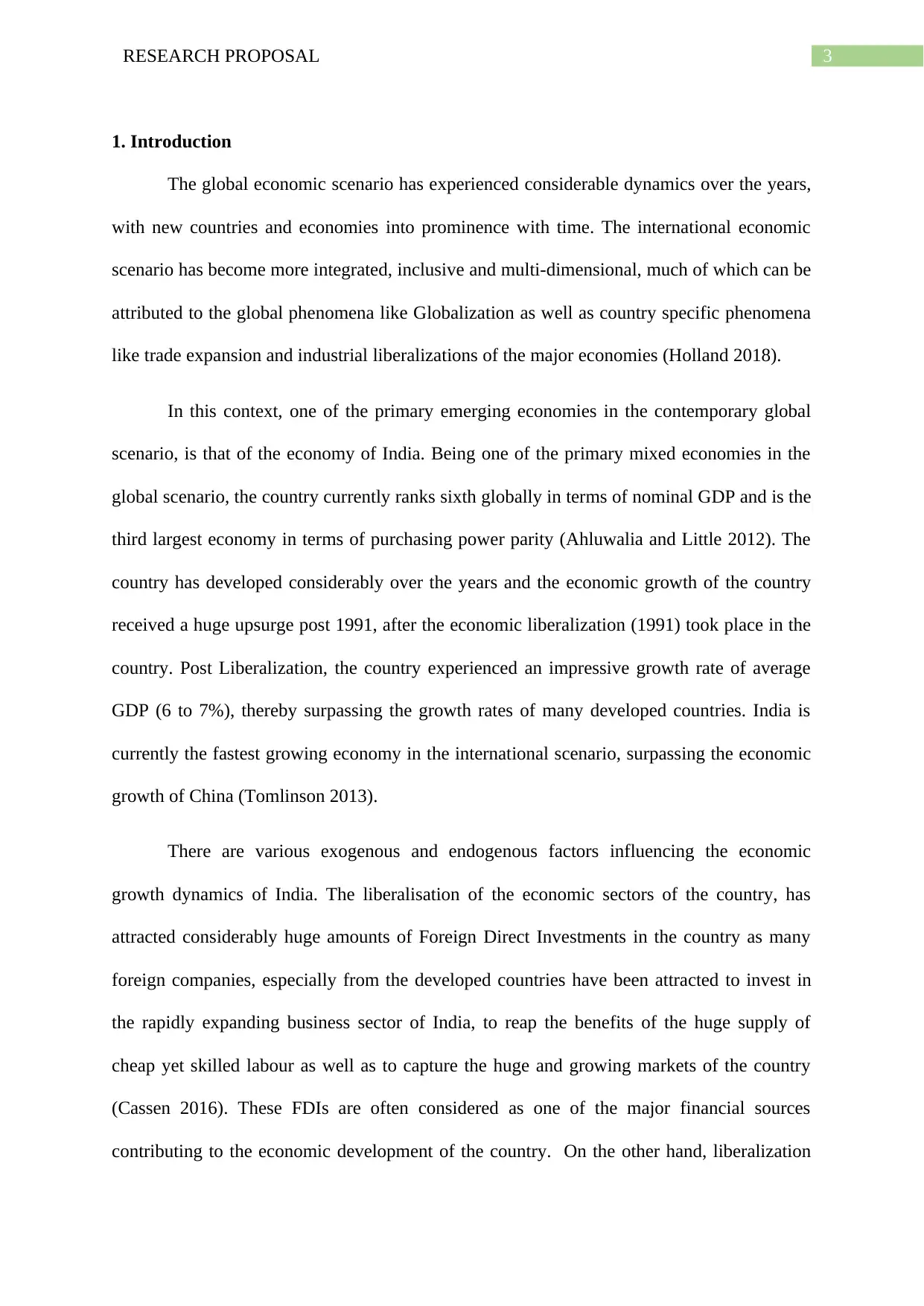
3RESEARCH PROPOSAL
1. Introduction
The global economic scenario has experienced considerable dynamics over the years,
with new countries and economies into prominence with time. The international economic
scenario has become more integrated, inclusive and multi-dimensional, much of which can be
attributed to the global phenomena like Globalization as well as country specific phenomena
like trade expansion and industrial liberalizations of the major economies (Holland 2018).
In this context, one of the primary emerging economies in the contemporary global
scenario, is that of the economy of India. Being one of the primary mixed economies in the
global scenario, the country currently ranks sixth globally in terms of nominal GDP and is the
third largest economy in terms of purchasing power parity (Ahluwalia and Little 2012). The
country has developed considerably over the years and the economic growth of the country
received a huge upsurge post 1991, after the economic liberalization (1991) took place in the
country. Post Liberalization, the country experienced an impressive growth rate of average
GDP (6 to 7%), thereby surpassing the growth rates of many developed countries. India is
currently the fastest growing economy in the international scenario, surpassing the economic
growth of China (Tomlinson 2013).
There are various exogenous and endogenous factors influencing the economic
growth dynamics of India. The liberalisation of the economic sectors of the country, has
attracted considerably huge amounts of Foreign Direct Investments in the country as many
foreign companies, especially from the developed countries have been attracted to invest in
the rapidly expanding business sector of India, to reap the benefits of the huge supply of
cheap yet skilled labour as well as to capture the huge and growing markets of the country
(Cassen 2016). These FDIs are often considered as one of the major financial sources
contributing to the economic development of the country. On the other hand, liberalization
1. Introduction
The global economic scenario has experienced considerable dynamics over the years,
with new countries and economies into prominence with time. The international economic
scenario has become more integrated, inclusive and multi-dimensional, much of which can be
attributed to the global phenomena like Globalization as well as country specific phenomena
like trade expansion and industrial liberalizations of the major economies (Holland 2018).
In this context, one of the primary emerging economies in the contemporary global
scenario, is that of the economy of India. Being one of the primary mixed economies in the
global scenario, the country currently ranks sixth globally in terms of nominal GDP and is the
third largest economy in terms of purchasing power parity (Ahluwalia and Little 2012). The
country has developed considerably over the years and the economic growth of the country
received a huge upsurge post 1991, after the economic liberalization (1991) took place in the
country. Post Liberalization, the country experienced an impressive growth rate of average
GDP (6 to 7%), thereby surpassing the growth rates of many developed countries. India is
currently the fastest growing economy in the international scenario, surpassing the economic
growth of China (Tomlinson 2013).
There are various exogenous and endogenous factors influencing the economic
growth dynamics of India. The liberalisation of the economic sectors of the country, has
attracted considerably huge amounts of Foreign Direct Investments in the country as many
foreign companies, especially from the developed countries have been attracted to invest in
the rapidly expanding business sector of India, to reap the benefits of the huge supply of
cheap yet skilled labour as well as to capture the huge and growing markets of the country
(Cassen 2016). These FDIs are often considered as one of the major financial sources
contributing to the economic development of the country. On the other hand, liberalization
Secure Best Marks with AI Grader
Need help grading? Try our AI Grader for instant feedback on your assignments.
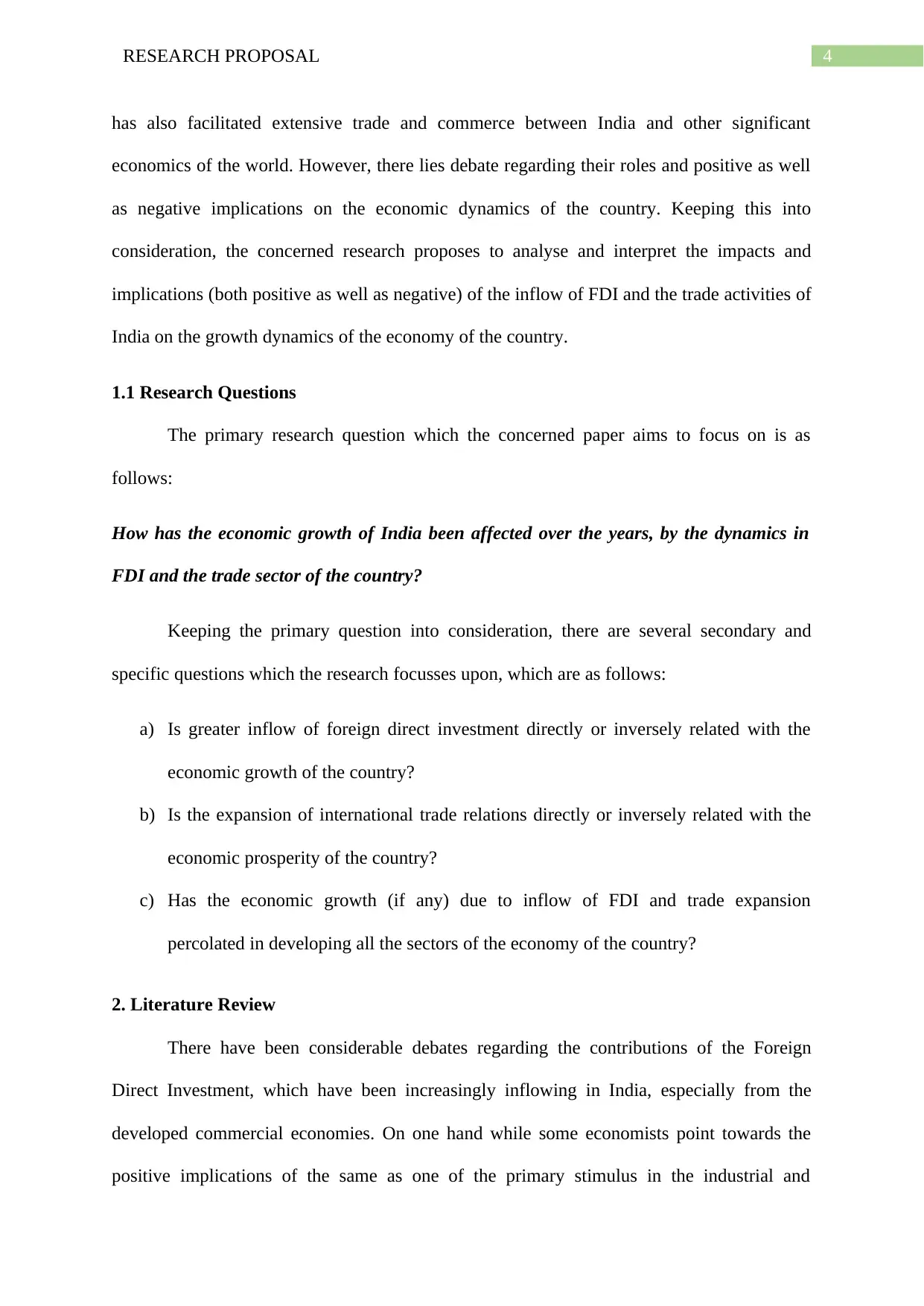
4RESEARCH PROPOSAL
has also facilitated extensive trade and commerce between India and other significant
economics of the world. However, there lies debate regarding their roles and positive as well
as negative implications on the economic dynamics of the country. Keeping this into
consideration, the concerned research proposes to analyse and interpret the impacts and
implications (both positive as well as negative) of the inflow of FDI and the trade activities of
India on the growth dynamics of the economy of the country.
1.1 Research Questions
The primary research question which the concerned paper aims to focus on is as
follows:
How has the economic growth of India been affected over the years, by the dynamics in
FDI and the trade sector of the country?
Keeping the primary question into consideration, there are several secondary and
specific questions which the research focusses upon, which are as follows:
a) Is greater inflow of foreign direct investment directly or inversely related with the
economic growth of the country?
b) Is the expansion of international trade relations directly or inversely related with the
economic prosperity of the country?
c) Has the economic growth (if any) due to inflow of FDI and trade expansion
percolated in developing all the sectors of the economy of the country?
2. Literature Review
There have been considerable debates regarding the contributions of the Foreign
Direct Investment, which have been increasingly inflowing in India, especially from the
developed commercial economies. On one hand while some economists point towards the
positive implications of the same as one of the primary stimulus in the industrial and
has also facilitated extensive trade and commerce between India and other significant
economics of the world. However, there lies debate regarding their roles and positive as well
as negative implications on the economic dynamics of the country. Keeping this into
consideration, the concerned research proposes to analyse and interpret the impacts and
implications (both positive as well as negative) of the inflow of FDI and the trade activities of
India on the growth dynamics of the economy of the country.
1.1 Research Questions
The primary research question which the concerned paper aims to focus on is as
follows:
How has the economic growth of India been affected over the years, by the dynamics in
FDI and the trade sector of the country?
Keeping the primary question into consideration, there are several secondary and
specific questions which the research focusses upon, which are as follows:
a) Is greater inflow of foreign direct investment directly or inversely related with the
economic growth of the country?
b) Is the expansion of international trade relations directly or inversely related with the
economic prosperity of the country?
c) Has the economic growth (if any) due to inflow of FDI and trade expansion
percolated in developing all the sectors of the economy of the country?
2. Literature Review
There have been considerable debates regarding the contributions of the Foreign
Direct Investment, which have been increasingly inflowing in India, especially from the
developed commercial economies. On one hand while some economists point towards the
positive implications of the same as one of the primary stimulus in the industrial and
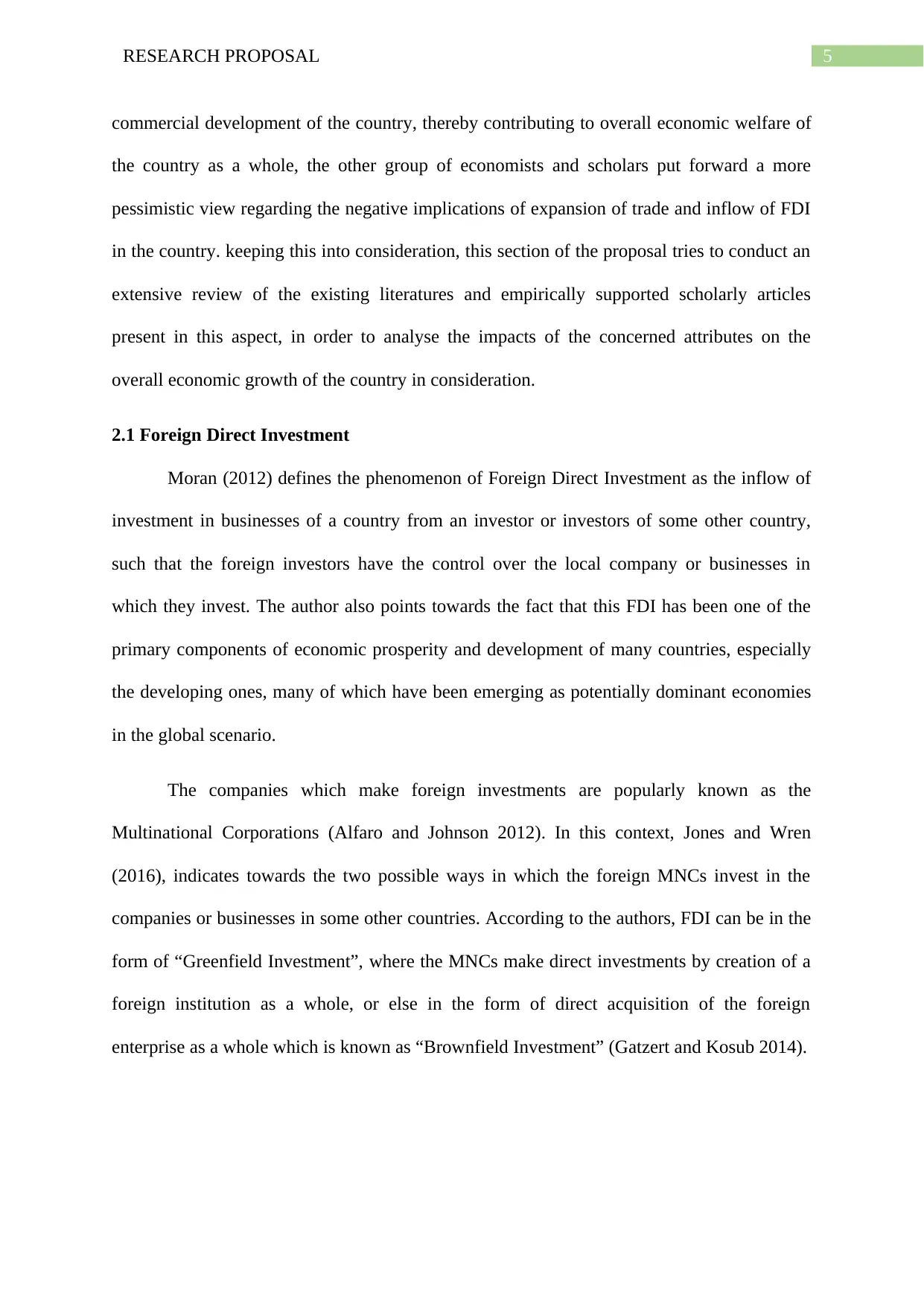
5RESEARCH PROPOSAL
commercial development of the country, thereby contributing to overall economic welfare of
the country as a whole, the other group of economists and scholars put forward a more
pessimistic view regarding the negative implications of expansion of trade and inflow of FDI
in the country. keeping this into consideration, this section of the proposal tries to conduct an
extensive review of the existing literatures and empirically supported scholarly articles
present in this aspect, in order to analyse the impacts of the concerned attributes on the
overall economic growth of the country in consideration.
2.1 Foreign Direct Investment
Moran (2012) defines the phenomenon of Foreign Direct Investment as the inflow of
investment in businesses of a country from an investor or investors of some other country,
such that the foreign investors have the control over the local company or businesses in
which they invest. The author also points towards the fact that this FDI has been one of the
primary components of economic prosperity and development of many countries, especially
the developing ones, many of which have been emerging as potentially dominant economies
in the global scenario.
The companies which make foreign investments are popularly known as the
Multinational Corporations (Alfaro and Johnson 2012). In this context, Jones and Wren
(2016), indicates towards the two possible ways in which the foreign MNCs invest in the
companies or businesses in some other countries. According to the authors, FDI can be in the
form of “Greenfield Investment”, where the MNCs make direct investments by creation of a
foreign institution as a whole, or else in the form of direct acquisition of the foreign
enterprise as a whole which is known as “Brownfield Investment” (Gatzert and Kosub 2014).
commercial development of the country, thereby contributing to overall economic welfare of
the country as a whole, the other group of economists and scholars put forward a more
pessimistic view regarding the negative implications of expansion of trade and inflow of FDI
in the country. keeping this into consideration, this section of the proposal tries to conduct an
extensive review of the existing literatures and empirically supported scholarly articles
present in this aspect, in order to analyse the impacts of the concerned attributes on the
overall economic growth of the country in consideration.
2.1 Foreign Direct Investment
Moran (2012) defines the phenomenon of Foreign Direct Investment as the inflow of
investment in businesses of a country from an investor or investors of some other country,
such that the foreign investors have the control over the local company or businesses in
which they invest. The author also points towards the fact that this FDI has been one of the
primary components of economic prosperity and development of many countries, especially
the developing ones, many of which have been emerging as potentially dominant economies
in the global scenario.
The companies which make foreign investments are popularly known as the
Multinational Corporations (Alfaro and Johnson 2012). In this context, Jones and Wren
(2016), indicates towards the two possible ways in which the foreign MNCs invest in the
companies or businesses in some other countries. According to the authors, FDI can be in the
form of “Greenfield Investment”, where the MNCs make direct investments by creation of a
foreign institution as a whole, or else in the form of direct acquisition of the foreign
enterprise as a whole which is known as “Brownfield Investment” (Gatzert and Kosub 2014).

6RESEARCH PROPOSAL
2.2 Pattern of FDI in India
There exists considerable empirically supported literary evidences, which try to show
the trend of the inflow of FDI in India over the years. According to the empirically supported
literary works of Goel, Kumar and Rao (2012), the inflow of the FDI in India has specifically
increased visibly post the implementation of the liberalization policy in the economy of the
country in 1991, which resulted in the removal of many of the restrictive and regulated trade
practices. The trend of FDI flow in the country, as asserted by the authors, can be shown with
the help of the following figure:
Figure 1: Trends in the FDI in India over the years
(Source: Theindiaeconomyreview.org 2018)
As is evident from the above figure, the FDI inflow in the country started post 1991,
with the extents increasing with time. However, there has been a considerable upsurge in the
inflow of the same in the country post 2000, much of which can be attributed to the growth of
the industrial and service sectors in the country.
2.2 Pattern of FDI in India
There exists considerable empirically supported literary evidences, which try to show
the trend of the inflow of FDI in India over the years. According to the empirically supported
literary works of Goel, Kumar and Rao (2012), the inflow of the FDI in India has specifically
increased visibly post the implementation of the liberalization policy in the economy of the
country in 1991, which resulted in the removal of many of the restrictive and regulated trade
practices. The trend of FDI flow in the country, as asserted by the authors, can be shown with
the help of the following figure:
Figure 1: Trends in the FDI in India over the years
(Source: Theindiaeconomyreview.org 2018)
As is evident from the above figure, the FDI inflow in the country started post 1991,
with the extents increasing with time. However, there has been a considerable upsurge in the
inflow of the same in the country post 2000, much of which can be attributed to the growth of
the industrial and service sectors in the country.
Paraphrase This Document
Need a fresh take? Get an instant paraphrase of this document with our AI Paraphraser

7RESEARCH PROPOSAL
Sahni (2012) finds a direct linkage of the inflow of FDI with the phenomenon of trade
openness in India. The Trade Openness index, showing the total trade volume (Imports +
Exports) as a percentage of GDP of the country, increases when the country starts involving
in more trade and commercial activities (especially international). In case of India, the pattern
of the same can be seen as follows:
Figure 2: Dynamics in the Trade Openness in India over the years
(Source: Theindiaeconomyreview.org 2018)
2.3 Determinants of FDI in India
There exists different opinions and literary evidences regarding the factors which
determine FDI inflow in India. In this context, Baby and Sharma (2017), in their paper, with
the help of statistical analysis points towards the importance of the factors primarily like that
of the GDP of the country, the trade openness, the size of the different markets in which the
investment inflows as well as the magnitude of inflation, interest rates and wage levels in the
country, in determining the FDI flow of the country (Mathur and Singh 2013).
Sahni (2012) finds a direct linkage of the inflow of FDI with the phenomenon of trade
openness in India. The Trade Openness index, showing the total trade volume (Imports +
Exports) as a percentage of GDP of the country, increases when the country starts involving
in more trade and commercial activities (especially international). In case of India, the pattern
of the same can be seen as follows:
Figure 2: Dynamics in the Trade Openness in India over the years
(Source: Theindiaeconomyreview.org 2018)
2.3 Determinants of FDI in India
There exists different opinions and literary evidences regarding the factors which
determine FDI inflow in India. In this context, Baby and Sharma (2017), in their paper, with
the help of statistical analysis points towards the importance of the factors primarily like that
of the GDP of the country, the trade openness, the size of the different markets in which the
investment inflows as well as the magnitude of inflation, interest rates and wage levels in the
country, in determining the FDI flow of the country (Mathur and Singh 2013).
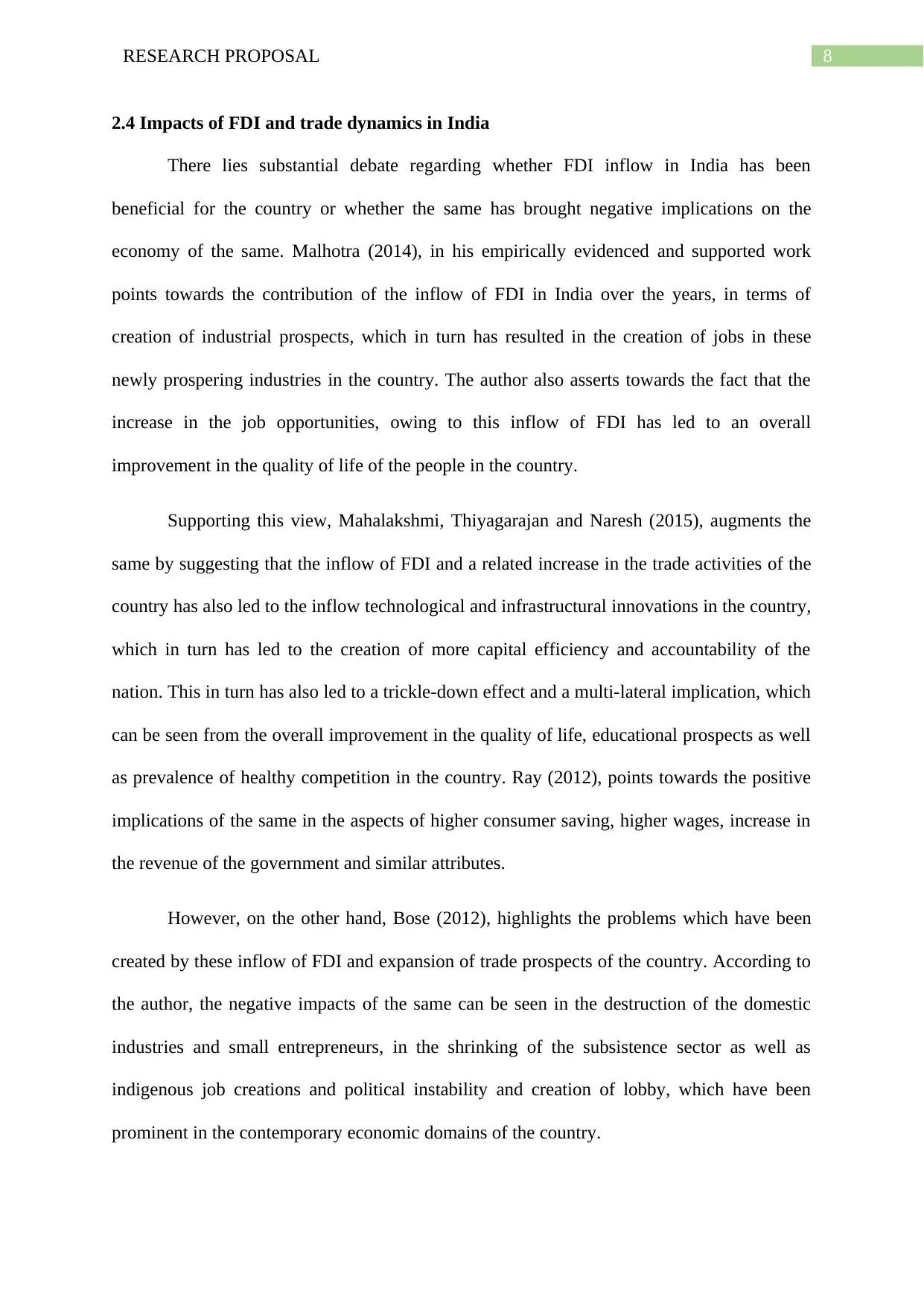
8RESEARCH PROPOSAL
2.4 Impacts of FDI and trade dynamics in India
There lies substantial debate regarding whether FDI inflow in India has been
beneficial for the country or whether the same has brought negative implications on the
economy of the same. Malhotra (2014), in his empirically evidenced and supported work
points towards the contribution of the inflow of FDI in India over the years, in terms of
creation of industrial prospects, which in turn has resulted in the creation of jobs in these
newly prospering industries in the country. The author also asserts towards the fact that the
increase in the job opportunities, owing to this inflow of FDI has led to an overall
improvement in the quality of life of the people in the country.
Supporting this view, Mahalakshmi, Thiyagarajan and Naresh (2015), augments the
same by suggesting that the inflow of FDI and a related increase in the trade activities of the
country has also led to the inflow technological and infrastructural innovations in the country,
which in turn has led to the creation of more capital efficiency and accountability of the
nation. This in turn has also led to a trickle-down effect and a multi-lateral implication, which
can be seen from the overall improvement in the quality of life, educational prospects as well
as prevalence of healthy competition in the country. Ray (2012), points towards the positive
implications of the same in the aspects of higher consumer saving, higher wages, increase in
the revenue of the government and similar attributes.
However, on the other hand, Bose (2012), highlights the problems which have been
created by these inflow of FDI and expansion of trade prospects of the country. According to
the author, the negative impacts of the same can be seen in the destruction of the domestic
industries and small entrepreneurs, in the shrinking of the subsistence sector as well as
indigenous job creations and political instability and creation of lobby, which have been
prominent in the contemporary economic domains of the country.
2.4 Impacts of FDI and trade dynamics in India
There lies substantial debate regarding whether FDI inflow in India has been
beneficial for the country or whether the same has brought negative implications on the
economy of the same. Malhotra (2014), in his empirically evidenced and supported work
points towards the contribution of the inflow of FDI in India over the years, in terms of
creation of industrial prospects, which in turn has resulted in the creation of jobs in these
newly prospering industries in the country. The author also asserts towards the fact that the
increase in the job opportunities, owing to this inflow of FDI has led to an overall
improvement in the quality of life of the people in the country.
Supporting this view, Mahalakshmi, Thiyagarajan and Naresh (2015), augments the
same by suggesting that the inflow of FDI and a related increase in the trade activities of the
country has also led to the inflow technological and infrastructural innovations in the country,
which in turn has led to the creation of more capital efficiency and accountability of the
nation. This in turn has also led to a trickle-down effect and a multi-lateral implication, which
can be seen from the overall improvement in the quality of life, educational prospects as well
as prevalence of healthy competition in the country. Ray (2012), points towards the positive
implications of the same in the aspects of higher consumer saving, higher wages, increase in
the revenue of the government and similar attributes.
However, on the other hand, Bose (2012), highlights the problems which have been
created by these inflow of FDI and expansion of trade prospects of the country. According to
the author, the negative impacts of the same can be seen in the destruction of the domestic
industries and small entrepreneurs, in the shrinking of the subsistence sector as well as
indigenous job creations and political instability and creation of lobby, which have been
prominent in the contemporary economic domains of the country.
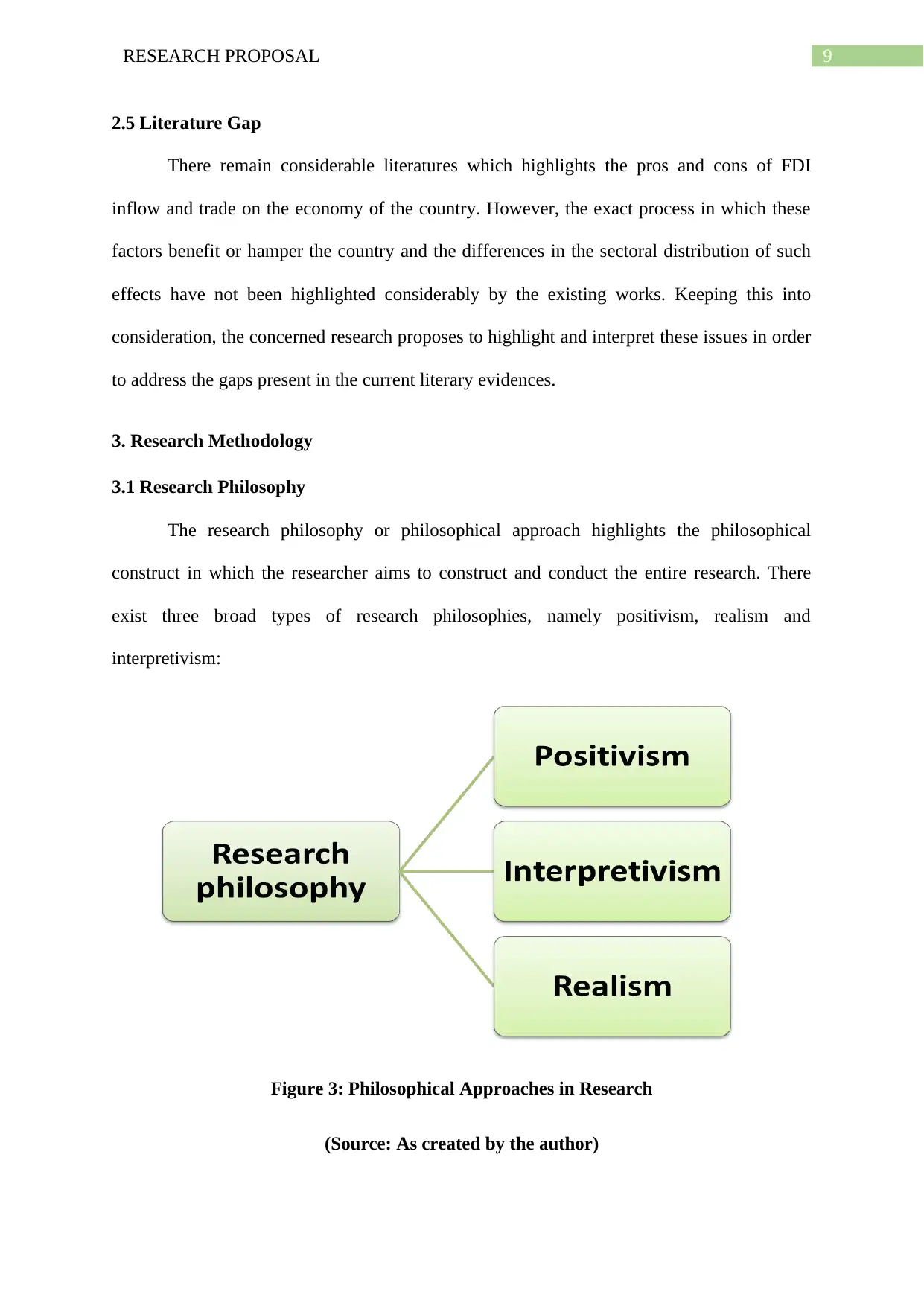
9RESEARCH PROPOSAL
2.5 Literature Gap
There remain considerable literatures which highlights the pros and cons of FDI
inflow and trade on the economy of the country. However, the exact process in which these
factors benefit or hamper the country and the differences in the sectoral distribution of such
effects have not been highlighted considerably by the existing works. Keeping this into
consideration, the concerned research proposes to highlight and interpret these issues in order
to address the gaps present in the current literary evidences.
3. Research Methodology
3.1 Research Philosophy
The research philosophy or philosophical approach highlights the philosophical
construct in which the researcher aims to construct and conduct the entire research. There
exist three broad types of research philosophies, namely positivism, realism and
interpretivism:
Figure 3: Philosophical Approaches in Research
(Source: As created by the author)
2.5 Literature Gap
There remain considerable literatures which highlights the pros and cons of FDI
inflow and trade on the economy of the country. However, the exact process in which these
factors benefit or hamper the country and the differences in the sectoral distribution of such
effects have not been highlighted considerably by the existing works. Keeping this into
consideration, the concerned research proposes to highlight and interpret these issues in order
to address the gaps present in the current literary evidences.
3. Research Methodology
3.1 Research Philosophy
The research philosophy or philosophical approach highlights the philosophical
construct in which the researcher aims to construct and conduct the entire research. There
exist three broad types of research philosophies, namely positivism, realism and
interpretivism:
Figure 3: Philosophical Approaches in Research
(Source: As created by the author)
Secure Best Marks with AI Grader
Need help grading? Try our AI Grader for instant feedback on your assignments.
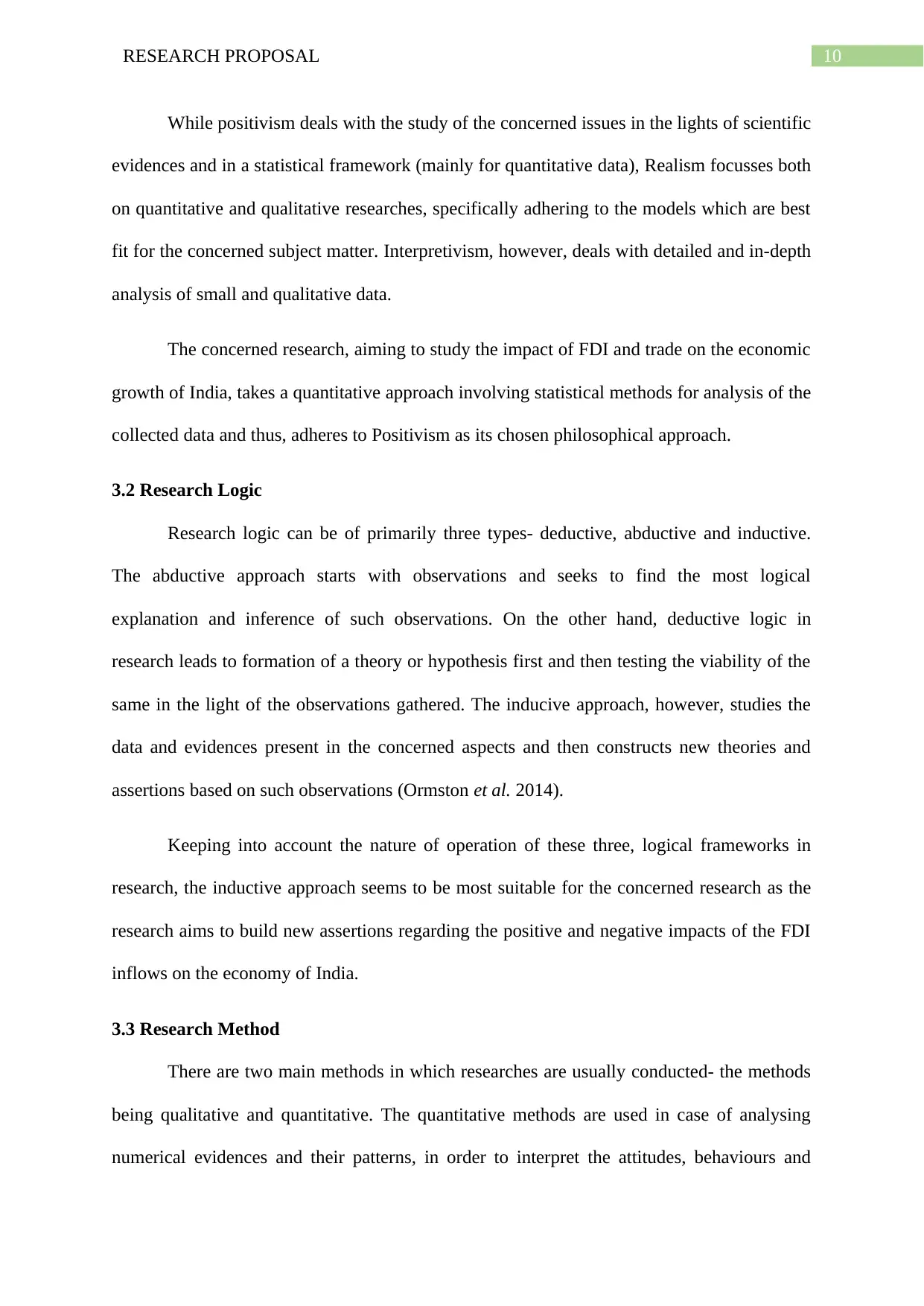
10RESEARCH PROPOSAL
While positivism deals with the study of the concerned issues in the lights of scientific
evidences and in a statistical framework (mainly for quantitative data), Realism focusses both
on quantitative and qualitative researches, specifically adhering to the models which are best
fit for the concerned subject matter. Interpretivism, however, deals with detailed and in-depth
analysis of small and qualitative data.
The concerned research, aiming to study the impact of FDI and trade on the economic
growth of India, takes a quantitative approach involving statistical methods for analysis of the
collected data and thus, adheres to Positivism as its chosen philosophical approach.
3.2 Research Logic
Research logic can be of primarily three types- deductive, abductive and inductive.
The abductive approach starts with observations and seeks to find the most logical
explanation and inference of such observations. On the other hand, deductive logic in
research leads to formation of a theory or hypothesis first and then testing the viability of the
same in the light of the observations gathered. The inducive approach, however, studies the
data and evidences present in the concerned aspects and then constructs new theories and
assertions based on such observations (Ormston et al. 2014).
Keeping into account the nature of operation of these three, logical frameworks in
research, the inductive approach seems to be most suitable for the concerned research as the
research aims to build new assertions regarding the positive and negative impacts of the FDI
inflows on the economy of India.
3.3 Research Method
There are two main methods in which researches are usually conducted- the methods
being qualitative and quantitative. The quantitative methods are used in case of analysing
numerical evidences and their patterns, in order to interpret the attitudes, behaviours and
While positivism deals with the study of the concerned issues in the lights of scientific
evidences and in a statistical framework (mainly for quantitative data), Realism focusses both
on quantitative and qualitative researches, specifically adhering to the models which are best
fit for the concerned subject matter. Interpretivism, however, deals with detailed and in-depth
analysis of small and qualitative data.
The concerned research, aiming to study the impact of FDI and trade on the economic
growth of India, takes a quantitative approach involving statistical methods for analysis of the
collected data and thus, adheres to Positivism as its chosen philosophical approach.
3.2 Research Logic
Research logic can be of primarily three types- deductive, abductive and inductive.
The abductive approach starts with observations and seeks to find the most logical
explanation and inference of such observations. On the other hand, deductive logic in
research leads to formation of a theory or hypothesis first and then testing the viability of the
same in the light of the observations gathered. The inducive approach, however, studies the
data and evidences present in the concerned aspects and then constructs new theories and
assertions based on such observations (Ormston et al. 2014).
Keeping into account the nature of operation of these three, logical frameworks in
research, the inductive approach seems to be most suitable for the concerned research as the
research aims to build new assertions regarding the positive and negative impacts of the FDI
inflows on the economy of India.
3.3 Research Method
There are two main methods in which researches are usually conducted- the methods
being qualitative and quantitative. The quantitative methods are used in case of analysing
numerical evidences and their patterns, in order to interpret the attitudes, behaviours and
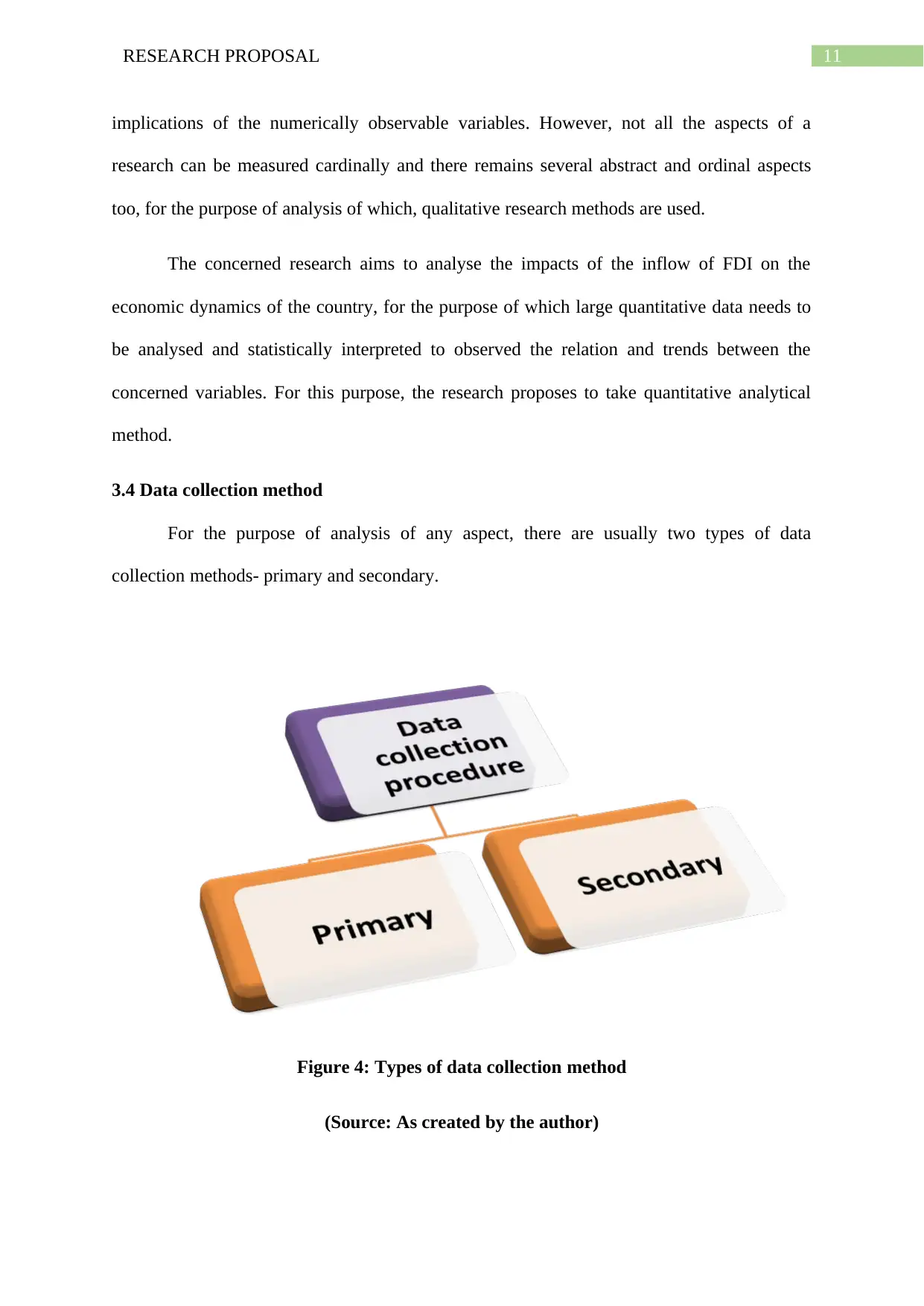
11RESEARCH PROPOSAL
implications of the numerically observable variables. However, not all the aspects of a
research can be measured cardinally and there remains several abstract and ordinal aspects
too, for the purpose of analysis of which, qualitative research methods are used.
The concerned research aims to analyse the impacts of the inflow of FDI on the
economic dynamics of the country, for the purpose of which large quantitative data needs to
be analysed and statistically interpreted to observed the relation and trends between the
concerned variables. For this purpose, the research proposes to take quantitative analytical
method.
3.4 Data collection method
For the purpose of analysis of any aspect, there are usually two types of data
collection methods- primary and secondary.
Figure 4: Types of data collection method
(Source: As created by the author)
implications of the numerically observable variables. However, not all the aspects of a
research can be measured cardinally and there remains several abstract and ordinal aspects
too, for the purpose of analysis of which, qualitative research methods are used.
The concerned research aims to analyse the impacts of the inflow of FDI on the
economic dynamics of the country, for the purpose of which large quantitative data needs to
be analysed and statistically interpreted to observed the relation and trends between the
concerned variables. For this purpose, the research proposes to take quantitative analytical
method.
3.4 Data collection method
For the purpose of analysis of any aspect, there are usually two types of data
collection methods- primary and secondary.
Figure 4: Types of data collection method
(Source: As created by the author)
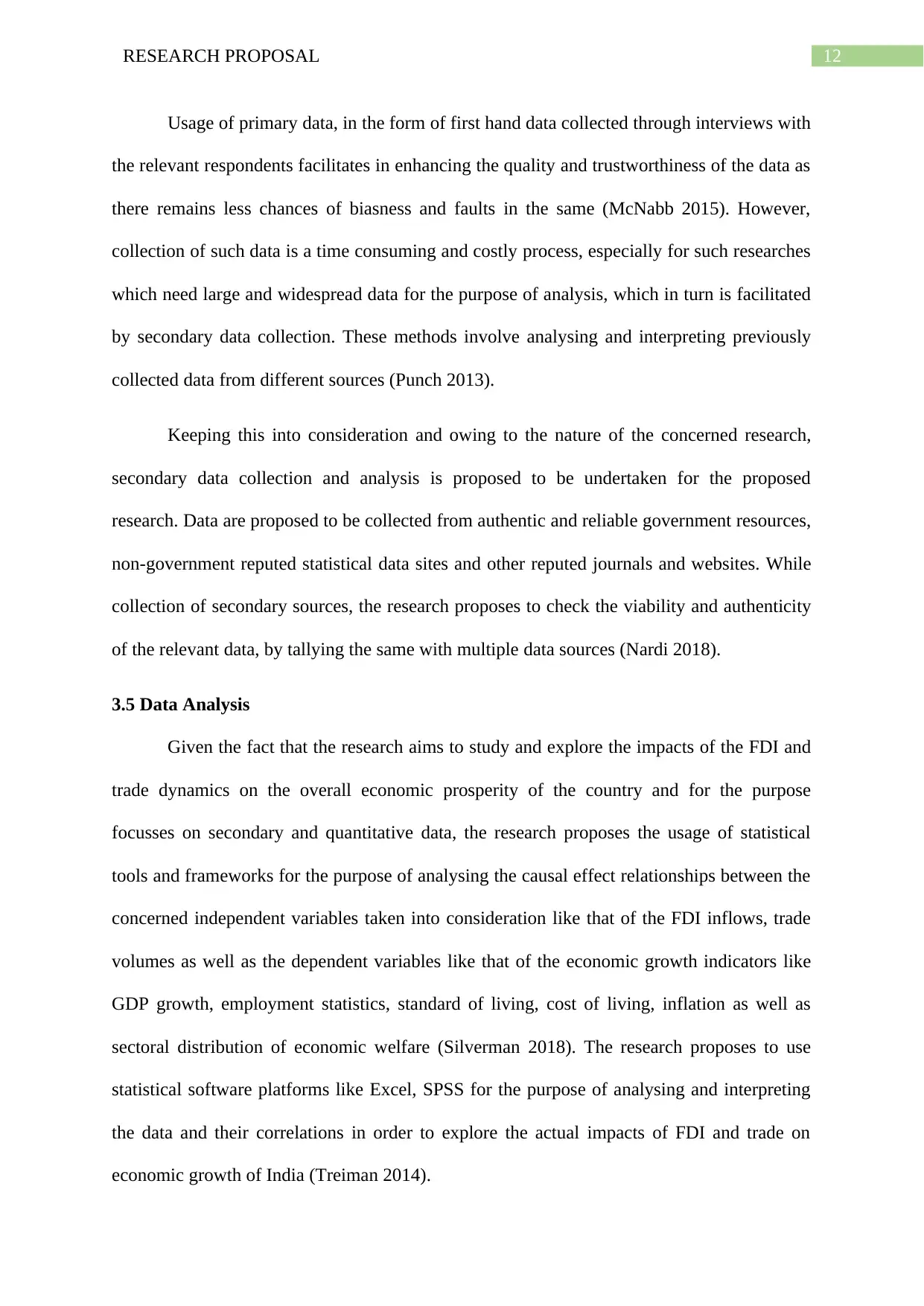
12RESEARCH PROPOSAL
Usage of primary data, in the form of first hand data collected through interviews with
the relevant respondents facilitates in enhancing the quality and trustworthiness of the data as
there remains less chances of biasness and faults in the same (McNabb 2015). However,
collection of such data is a time consuming and costly process, especially for such researches
which need large and widespread data for the purpose of analysis, which in turn is facilitated
by secondary data collection. These methods involve analysing and interpreting previously
collected data from different sources (Punch 2013).
Keeping this into consideration and owing to the nature of the concerned research,
secondary data collection and analysis is proposed to be undertaken for the proposed
research. Data are proposed to be collected from authentic and reliable government resources,
non-government reputed statistical data sites and other reputed journals and websites. While
collection of secondary sources, the research proposes to check the viability and authenticity
of the relevant data, by tallying the same with multiple data sources (Nardi 2018).
3.5 Data Analysis
Given the fact that the research aims to study and explore the impacts of the FDI and
trade dynamics on the overall economic prosperity of the country and for the purpose
focusses on secondary and quantitative data, the research proposes the usage of statistical
tools and frameworks for the purpose of analysing the causal effect relationships between the
concerned independent variables taken into consideration like that of the FDI inflows, trade
volumes as well as the dependent variables like that of the economic growth indicators like
GDP growth, employment statistics, standard of living, cost of living, inflation as well as
sectoral distribution of economic welfare (Silverman 2018). The research proposes to use
statistical software platforms like Excel, SPSS for the purpose of analysing and interpreting
the data and their correlations in order to explore the actual impacts of FDI and trade on
economic growth of India (Treiman 2014).
Usage of primary data, in the form of first hand data collected through interviews with
the relevant respondents facilitates in enhancing the quality and trustworthiness of the data as
there remains less chances of biasness and faults in the same (McNabb 2015). However,
collection of such data is a time consuming and costly process, especially for such researches
which need large and widespread data for the purpose of analysis, which in turn is facilitated
by secondary data collection. These methods involve analysing and interpreting previously
collected data from different sources (Punch 2013).
Keeping this into consideration and owing to the nature of the concerned research,
secondary data collection and analysis is proposed to be undertaken for the proposed
research. Data are proposed to be collected from authentic and reliable government resources,
non-government reputed statistical data sites and other reputed journals and websites. While
collection of secondary sources, the research proposes to check the viability and authenticity
of the relevant data, by tallying the same with multiple data sources (Nardi 2018).
3.5 Data Analysis
Given the fact that the research aims to study and explore the impacts of the FDI and
trade dynamics on the overall economic prosperity of the country and for the purpose
focusses on secondary and quantitative data, the research proposes the usage of statistical
tools and frameworks for the purpose of analysing the causal effect relationships between the
concerned independent variables taken into consideration like that of the FDI inflows, trade
volumes as well as the dependent variables like that of the economic growth indicators like
GDP growth, employment statistics, standard of living, cost of living, inflation as well as
sectoral distribution of economic welfare (Silverman 2018). The research proposes to use
statistical software platforms like Excel, SPSS for the purpose of analysing and interpreting
the data and their correlations in order to explore the actual impacts of FDI and trade on
economic growth of India (Treiman 2014).
Paraphrase This Document
Need a fresh take? Get an instant paraphrase of this document with our AI Paraphraser
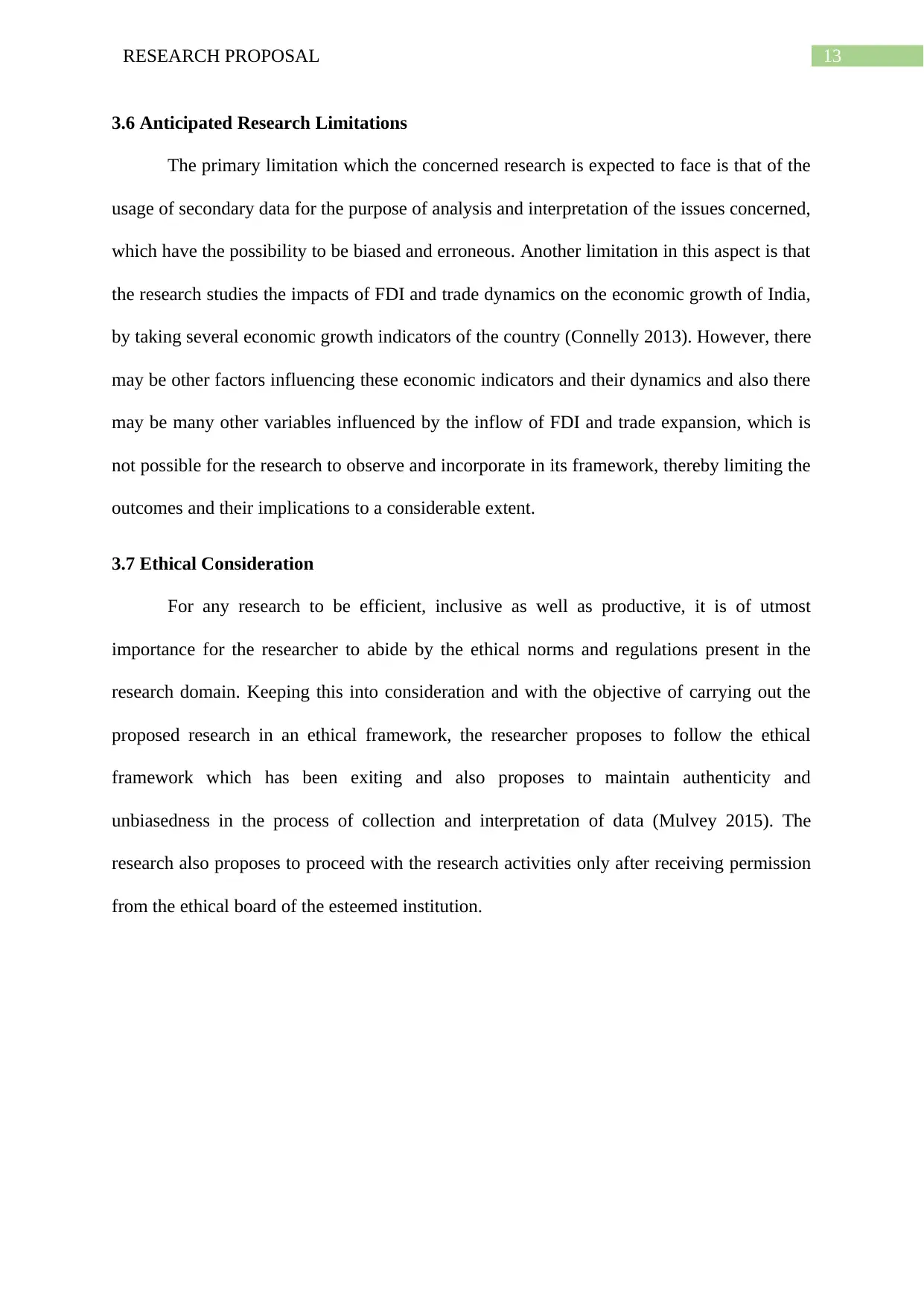
13RESEARCH PROPOSAL
3.6 Anticipated Research Limitations
The primary limitation which the concerned research is expected to face is that of the
usage of secondary data for the purpose of analysis and interpretation of the issues concerned,
which have the possibility to be biased and erroneous. Another limitation in this aspect is that
the research studies the impacts of FDI and trade dynamics on the economic growth of India,
by taking several economic growth indicators of the country (Connelly 2013). However, there
may be other factors influencing these economic indicators and their dynamics and also there
may be many other variables influenced by the inflow of FDI and trade expansion, which is
not possible for the research to observe and incorporate in its framework, thereby limiting the
outcomes and their implications to a considerable extent.
3.7 Ethical Consideration
For any research to be efficient, inclusive as well as productive, it is of utmost
importance for the researcher to abide by the ethical norms and regulations present in the
research domain. Keeping this into consideration and with the objective of carrying out the
proposed research in an ethical framework, the researcher proposes to follow the ethical
framework which has been exiting and also proposes to maintain authenticity and
unbiasedness in the process of collection and interpretation of data (Mulvey 2015). The
research also proposes to proceed with the research activities only after receiving permission
from the ethical board of the esteemed institution.
3.6 Anticipated Research Limitations
The primary limitation which the concerned research is expected to face is that of the
usage of secondary data for the purpose of analysis and interpretation of the issues concerned,
which have the possibility to be biased and erroneous. Another limitation in this aspect is that
the research studies the impacts of FDI and trade dynamics on the economic growth of India,
by taking several economic growth indicators of the country (Connelly 2013). However, there
may be other factors influencing these economic indicators and their dynamics and also there
may be many other variables influenced by the inflow of FDI and trade expansion, which is
not possible for the research to observe and incorporate in its framework, thereby limiting the
outcomes and their implications to a considerable extent.
3.7 Ethical Consideration
For any research to be efficient, inclusive as well as productive, it is of utmost
importance for the researcher to abide by the ethical norms and regulations present in the
research domain. Keeping this into consideration and with the objective of carrying out the
proposed research in an ethical framework, the researcher proposes to follow the ethical
framework which has been exiting and also proposes to maintain authenticity and
unbiasedness in the process of collection and interpretation of data (Mulvey 2015). The
research also proposes to proceed with the research activities only after receiving permission
from the ethical board of the esteemed institution.

14RESEARCH PROPOSAL
4. Research Timetable
Activities Week 1 Week 2 Week 3 Week 4 and 5
Ideation of the
research
Research design
Secondary data
collection and
data sorting
process
Data analysis
and
interpretation
and report
construction
Publication
4. Research Timetable
Activities Week 1 Week 2 Week 3 Week 4 and 5
Ideation of the
research
Research design
Secondary data
collection and
data sorting
process
Data analysis
and
interpretation
and report
construction
Publication
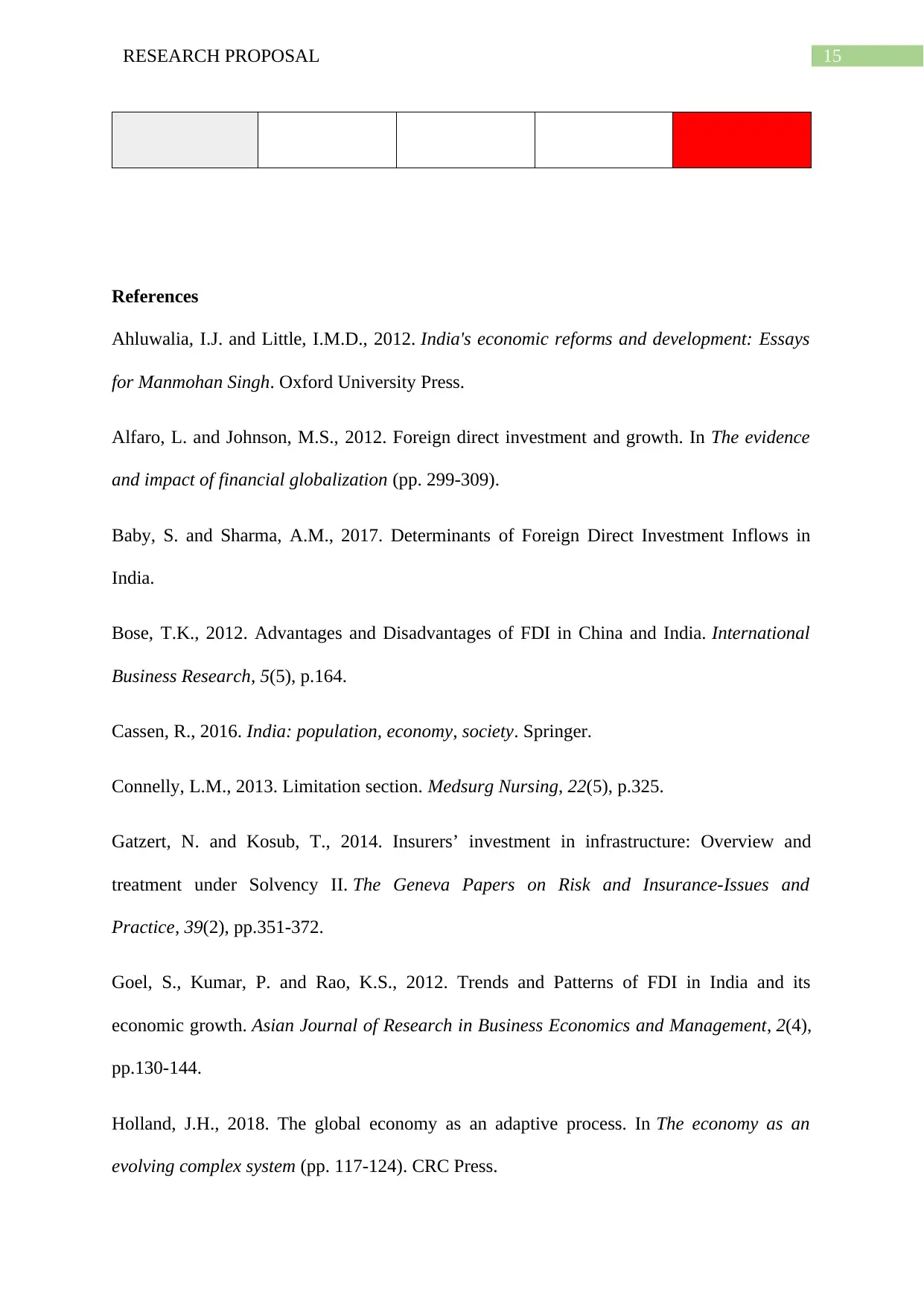
15RESEARCH PROPOSAL
References
Ahluwalia, I.J. and Little, I.M.D., 2012. India's economic reforms and development: Essays
for Manmohan Singh. Oxford University Press.
Alfaro, L. and Johnson, M.S., 2012. Foreign direct investment and growth. In The evidence
and impact of financial globalization (pp. 299-309).
Baby, S. and Sharma, A.M., 2017. Determinants of Foreign Direct Investment Inflows in
India.
Bose, T.K., 2012. Advantages and Disadvantages of FDI in China and India. International
Business Research, 5(5), p.164.
Cassen, R., 2016. India: population, economy, society. Springer.
Connelly, L.M., 2013. Limitation section. Medsurg Nursing, 22(5), p.325.
Gatzert, N. and Kosub, T., 2014. Insurers’ investment in infrastructure: Overview and
treatment under Solvency II. The Geneva Papers on Risk and Insurance-Issues and
Practice, 39(2), pp.351-372.
Goel, S., Kumar, P. and Rao, K.S., 2012. Trends and Patterns of FDI in India and its
economic growth. Asian Journal of Research in Business Economics and Management, 2(4),
pp.130-144.
Holland, J.H., 2018. The global economy as an adaptive process. In The economy as an
evolving complex system (pp. 117-124). CRC Press.
References
Ahluwalia, I.J. and Little, I.M.D., 2012. India's economic reforms and development: Essays
for Manmohan Singh. Oxford University Press.
Alfaro, L. and Johnson, M.S., 2012. Foreign direct investment and growth. In The evidence
and impact of financial globalization (pp. 299-309).
Baby, S. and Sharma, A.M., 2017. Determinants of Foreign Direct Investment Inflows in
India.
Bose, T.K., 2012. Advantages and Disadvantages of FDI in China and India. International
Business Research, 5(5), p.164.
Cassen, R., 2016. India: population, economy, society. Springer.
Connelly, L.M., 2013. Limitation section. Medsurg Nursing, 22(5), p.325.
Gatzert, N. and Kosub, T., 2014. Insurers’ investment in infrastructure: Overview and
treatment under Solvency II. The Geneva Papers on Risk and Insurance-Issues and
Practice, 39(2), pp.351-372.
Goel, S., Kumar, P. and Rao, K.S., 2012. Trends and Patterns of FDI in India and its
economic growth. Asian Journal of Research in Business Economics and Management, 2(4),
pp.130-144.
Holland, J.H., 2018. The global economy as an adaptive process. In The economy as an
evolving complex system (pp. 117-124). CRC Press.
Secure Best Marks with AI Grader
Need help grading? Try our AI Grader for instant feedback on your assignments.
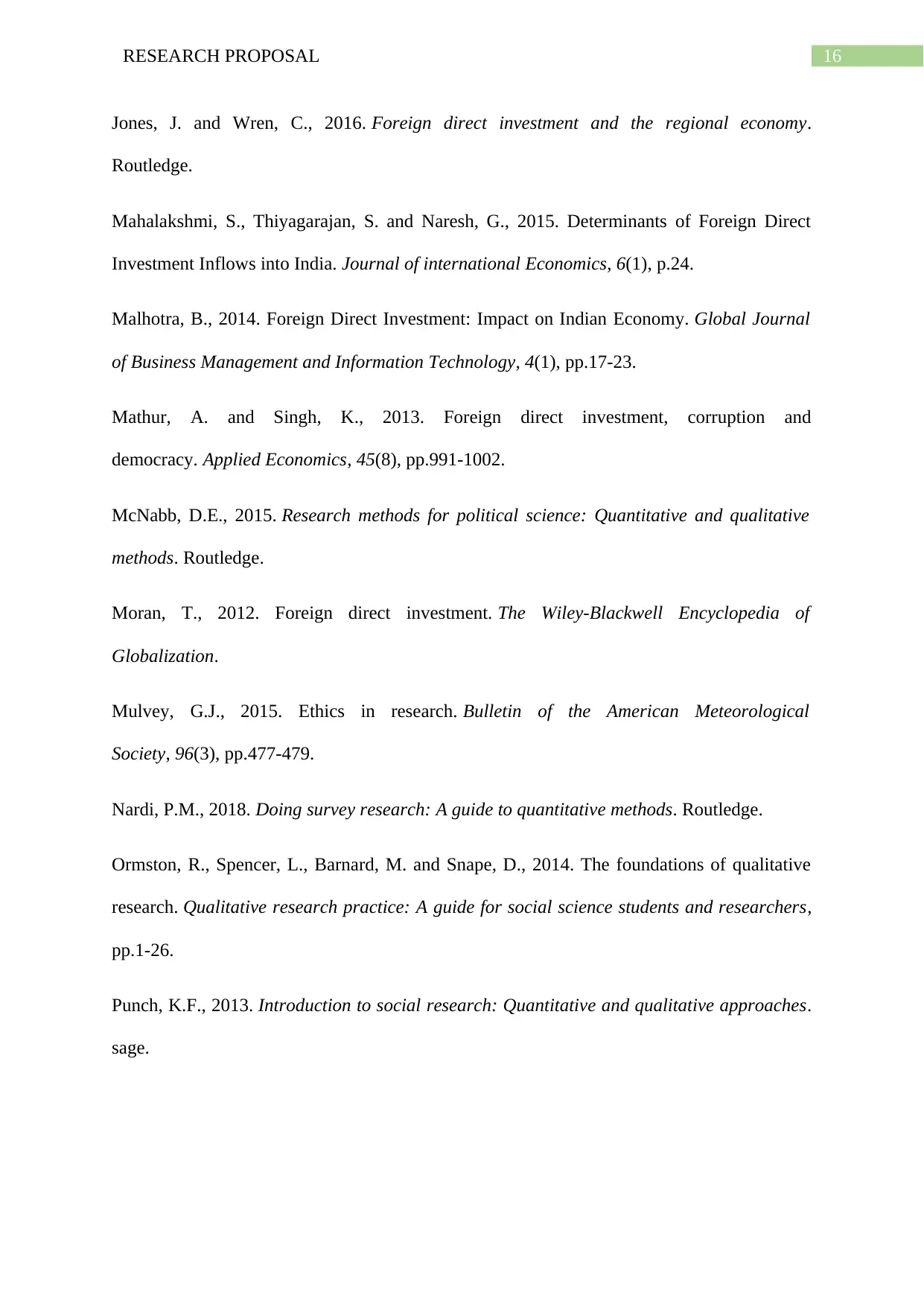
16RESEARCH PROPOSAL
Jones, J. and Wren, C., 2016. Foreign direct investment and the regional economy.
Routledge.
Mahalakshmi, S., Thiyagarajan, S. and Naresh, G., 2015. Determinants of Foreign Direct
Investment Inflows into India. Journal of international Economics, 6(1), p.24.
Malhotra, B., 2014. Foreign Direct Investment: Impact on Indian Economy. Global Journal
of Business Management and Information Technology, 4(1), pp.17-23.
Mathur, A. and Singh, K., 2013. Foreign direct investment, corruption and
democracy. Applied Economics, 45(8), pp.991-1002.
McNabb, D.E., 2015. Research methods for political science: Quantitative and qualitative
methods. Routledge.
Moran, T., 2012. Foreign direct investment. The Wiley-Blackwell Encyclopedia of
Globalization.
Mulvey, G.J., 2015. Ethics in research. Bulletin of the American Meteorological
Society, 96(3), pp.477-479.
Nardi, P.M., 2018. Doing survey research: A guide to quantitative methods. Routledge.
Ormston, R., Spencer, L., Barnard, M. and Snape, D., 2014. The foundations of qualitative
research. Qualitative research practice: A guide for social science students and researchers,
pp.1-26.
Punch, K.F., 2013. Introduction to social research: Quantitative and qualitative approaches.
sage.
Jones, J. and Wren, C., 2016. Foreign direct investment and the regional economy.
Routledge.
Mahalakshmi, S., Thiyagarajan, S. and Naresh, G., 2015. Determinants of Foreign Direct
Investment Inflows into India. Journal of international Economics, 6(1), p.24.
Malhotra, B., 2014. Foreign Direct Investment: Impact on Indian Economy. Global Journal
of Business Management and Information Technology, 4(1), pp.17-23.
Mathur, A. and Singh, K., 2013. Foreign direct investment, corruption and
democracy. Applied Economics, 45(8), pp.991-1002.
McNabb, D.E., 2015. Research methods for political science: Quantitative and qualitative
methods. Routledge.
Moran, T., 2012. Foreign direct investment. The Wiley-Blackwell Encyclopedia of
Globalization.
Mulvey, G.J., 2015. Ethics in research. Bulletin of the American Meteorological
Society, 96(3), pp.477-479.
Nardi, P.M., 2018. Doing survey research: A guide to quantitative methods. Routledge.
Ormston, R., Spencer, L., Barnard, M. and Snape, D., 2014. The foundations of qualitative
research. Qualitative research practice: A guide for social science students and researchers,
pp.1-26.
Punch, K.F., 2013. Introduction to social research: Quantitative and qualitative approaches.
sage.
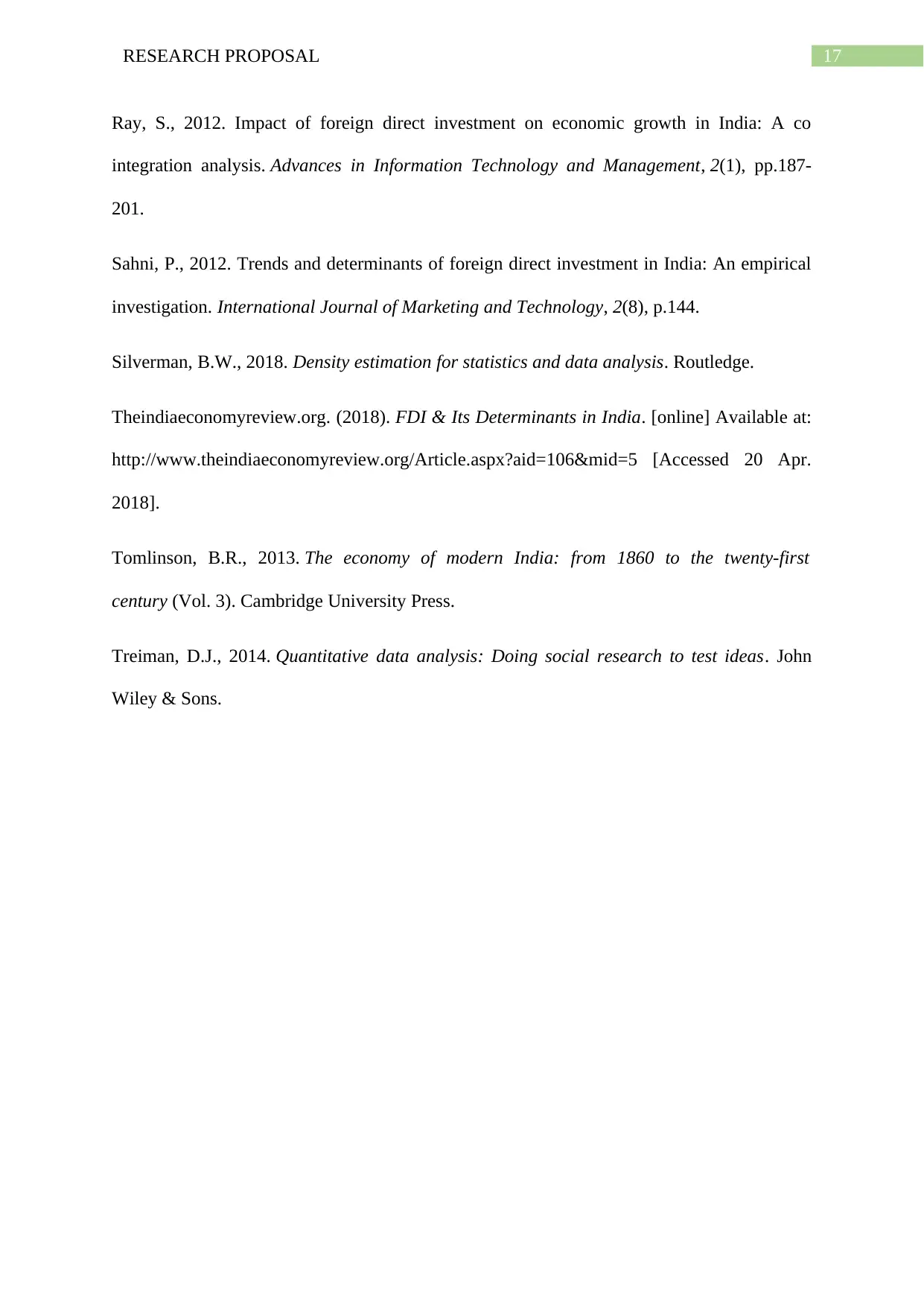
17RESEARCH PROPOSAL
Ray, S., 2012. Impact of foreign direct investment on economic growth in India: A co
integration analysis. Advances in Information Technology and Management, 2(1), pp.187-
201.
Sahni, P., 2012. Trends and determinants of foreign direct investment in India: An empirical
investigation. International Journal of Marketing and Technology, 2(8), p.144.
Silverman, B.W., 2018. Density estimation for statistics and data analysis. Routledge.
Theindiaeconomyreview.org. (2018). FDI & Its Determinants in India. [online] Available at:
http://www.theindiaeconomyreview.org/Article.aspx?aid=106&mid=5 [Accessed 20 Apr.
2018].
Tomlinson, B.R., 2013. The economy of modern India: from 1860 to the twenty-first
century (Vol. 3). Cambridge University Press.
Treiman, D.J., 2014. Quantitative data analysis: Doing social research to test ideas. John
Wiley & Sons.
Ray, S., 2012. Impact of foreign direct investment on economic growth in India: A co
integration analysis. Advances in Information Technology and Management, 2(1), pp.187-
201.
Sahni, P., 2012. Trends and determinants of foreign direct investment in India: An empirical
investigation. International Journal of Marketing and Technology, 2(8), p.144.
Silverman, B.W., 2018. Density estimation for statistics and data analysis. Routledge.
Theindiaeconomyreview.org. (2018). FDI & Its Determinants in India. [online] Available at:
http://www.theindiaeconomyreview.org/Article.aspx?aid=106&mid=5 [Accessed 20 Apr.
2018].
Tomlinson, B.R., 2013. The economy of modern India: from 1860 to the twenty-first
century (Vol. 3). Cambridge University Press.
Treiman, D.J., 2014. Quantitative data analysis: Doing social research to test ideas. John
Wiley & Sons.
1 out of 18
Related Documents
Your All-in-One AI-Powered Toolkit for Academic Success.
+13062052269
info@desklib.com
Available 24*7 on WhatsApp / Email
![[object Object]](/_next/static/media/star-bottom.7253800d.svg)
Unlock your academic potential
© 2024 | Zucol Services PVT LTD | All rights reserved.





